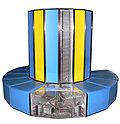
The Cray J90 series (code-named Jedi during development) was an air-cooled vector processor supercomputer first announced by Cray Research in 1994. [1]
Contents
The J90 evolved from the Cray Y-MP EL minisupercomputer, [2] and is compatible with Y-MP software, running the same UNICOS operating system. The later J90 models supported up to 32 CMOS processors with a 10 ns (100 MHz) clock. It supported up to 4 GB of main memory and up to 48 GB/s of memory bandwidth, giving it considerably less performance than the contemporary Cray T90, but making it a strong competitor to other technical computers in its price range.
All input/output in the early J90 models was handled by an IOS (Input/Output Subsystem) called IOS Model V. The IOS-V was based on the VME64 bus and SPARC I/O processors (IOPs) running the VxWorks RTOS. The IOS was programmed to emulate the IOS Model E, used in the larger Cray Y-MP systems, in order to minimize changes in the UNICOS operating system. By using standard VME boards, a wide variety of commodity peripherals could be used.

